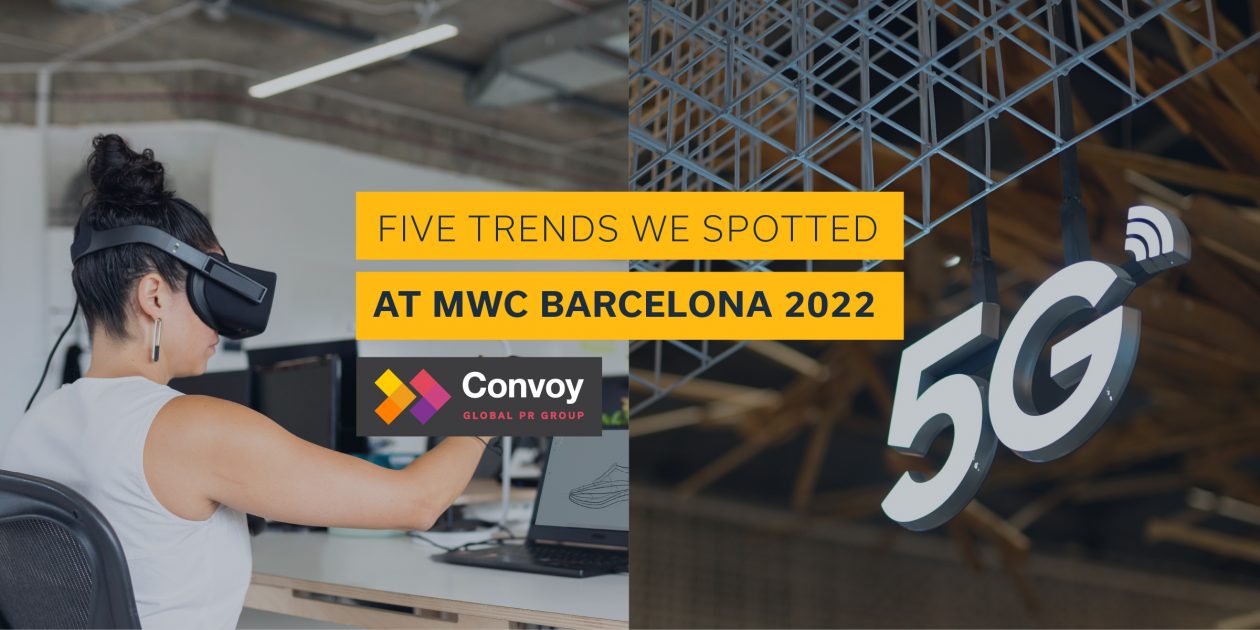Arantxa Aguilera, Director of B2B, Corporate & Digital at Convoy partner Canela Public Relations, was on the ground at MWC 2022. Here’s what she learned.
MWC 2022 fulfilled even the most ambitious expectations. The first edition of the congress since the pandemic closed with 61,000 visitors, 1,900 exhibitors from 200 countries and seven pavilions, confirming that face-to-face events are back with a vengeance. Despite not reaching 2019’s record visitor numbers, there was a clear sense of normality at MWC Barcelona 2022 and, above all, a desire to do business.
There was also no shortage of new products, from mobile devices that will be on sale this year to all kinds of apps and other specialised offerings. We can’t possibly list them all here, so here’s a summary of the five main trends we noticed at the event.
The metaverse, still in its early days
Unsurprisingly, the metaverse was a hot topic at MWC 2022. These virtual worlds that combine VR, AR and 3D graphics promise to revolutionise the way consumers and companies interact in the digital world. The metaverse technology on show at MWC was frankly promising, from the virtual platforms demonstrated by HTC or the Korean operator SK Telecom, to the futuristic holograms at the Telefónica stand.
In addition, Telefónica and Meta (formerly Facebook) have announced the creation of a Metaverse Innovation Hub in Madrid, where local developers will have access to a 5G lab to develop concepts aimed at the metaverse. However, we were left with the impression that it will take a fair few years before these ambitious goals become a reality!
No disruptive smartphones – but plenty of mobile gadgets
No folding phones, no holographic projectors, no virtual reality. While smartphones were, as always, the stars of MWC 2022, manufacturers generally opted for classic, tried-and-tested formats. In the numerous mobile phones presented, we saw innovation take the form of more power, increased resolution, or faster battery charging.
By contrast, eye-catching gadgets in the wider mobile device ecosystem included cyborg dogs, wearables for cats, smart toothbrushes and tattoo printers. There were also plenty of all-in-one computers and laptops – a segment that’s enjoying a resurgence given the rise of remote working – as well as unusual see-through TVs.
Tomorrow’s connectivity – Open RAN and WiFi 7
MWC Barcelona 2022 was not only a chance to see what’s new in tech, but also to anticipate future trends. In terms of connectivity, there are two technologies that we should keep an eye on in the coming years. One is the so-called Open RAN, an open standard for radio access network technologies that will drive the deployment of 5G in a more collaborative way. Open RAN makes it possible to deploy 5G without involving large network companies. This has allowed Rakuten, for example, to launch its own commercial 4G/5G network in Japan. Other operators, such as Telefónica, Vodafone and Orange, are currently starting to roll out this technology, which promises to bring 5G to the whole world.
The second is WiFi 7 – the next evolution of this protocol that will make wireless connections in homes and offices even faster. Qualcomm presented its first chip with WiFi 7 at MWC 2022.
Apps for new market segments
We saw a huge variety of mobile apps that aim to reach untapped market segments. Many of them were exhibited at 4YFN, a parallel event to MWC Barcelona that’s dedicated to start-ups, where numerous entrepreneurs compete to attract investors.
It’s safe to say that app designers weren’t lacking in creativity! Concepts vying to become the next tech unicorn included medical diagnostics based on facial recognition and mobile art collection.
It’s also worth remarking on the launch of Huawei’s AppTouch. This independent app shop marks the Chinese manufacturer’s latest effort to gain independence from Android.
Connected cars and Industry 4.0
In its more b2b dimension, MWC Barcelona 2022 gave us the opportunity to see the latest developments in electric, connected and even autonomous driving vehicles.
The Fisker Ocean, which was presented as a rival to Elon Musk’s Tesla, aroused particular interest. There were also concept cars from more traditional manufacturers, such as BMW, which are jumping on the electric mobility trend.
In terms of Industry 4.0, there was much talk at this year’s show about digital twins. In short, digital twins are virtual replicas of products, components and even machines or entire factories. Using AI, they make it possible to create all kinds of highly accurate interactive simulations.
Research firms such as Gartner and KPMG have already identified digital twins as the next big disruptive technology. In line with this, one of the winners of this year’s GLOMO awards (MWC’s tech awards programme) was the port of Tianjin in China, which is already using digital twins in combination with other technologies like 5G to enhance efficiency and improve visibility.
So, there you have it. That’s what we learned at this year’s edition of MWC. And boy, was it good to be back!
If you’re looking to launch an international b2b PR or marketing campaign, or if you’re an agency that wants to join the Convoy Global PR Group, get in touch at hello@rlyl.com.




